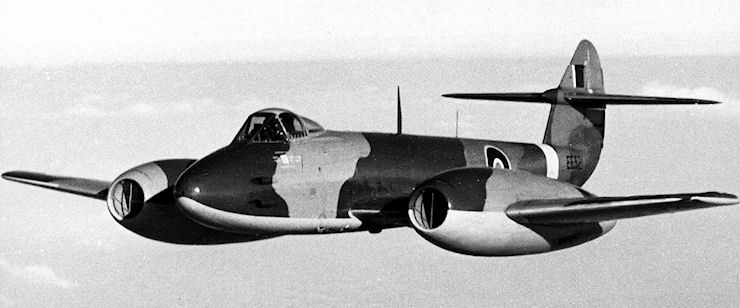

Tactical Trials Meteor III
Comparison with Tempest V
| Level Speeds.
128. The Meteor III is faster than the Tempest V at all heights. The following table gives the approximate comparitive figures at various heights with full throttle:- |
| Height | Speed T.A.S. | Difference | |
| Meteor | Tempest | ||
| 1,000 | 465 | 381 | 84 |
| 15,000 | 471 | 381 | 55 |
| 30,000 | 465 | 416 | 75 |
| 137. The Meteor has a high performance at low and medium altitude, its performance at high altitudes is moderate owing to the power output of the turbines being reduced by surging.
138. Range at 20,000 ft. with 180 gallon drop tank is 581 miles compared with the range of the Tempest of 809 miles at 5,000 ft. with two 45 gallon drop tanks. These heights are chosen as the average operating height of the two aircraft (See Appendix "C"). 139. The Meteor has an instability in yaw, ("snaking"), which makes it unsuitable as a gun platform at operational speeds. 140. It is pleasant to fly and handles satisfactorily except for the heaviness of the aileron control which is unsuitable for a fighter. This turbine jet engine gives slower acceleration at low speeds. 141. Dive brakes are valuable tactically on selected occasions and also for economical flying as they allow a steeper dive at the limiting speed and curtail the time and space occupied when reducing speed before landing. 142. The forward view is normally very good, but is bad in rain as the front and front-side panels become obscured. The clearness of vision to the rear is reduced by three transparent layers; and additionally it is difficult to clean the inner surface of the bubble canopy. (see Appendix "G"). 143. The position of the present cockpit lighting is not acceptable, but with the repositioning as suggested in para. 106 it becomes more satisfactory. 144. The armament of four 20 m.m. guns grouped in the nose is ideal, but the restricted adjustment makes harmonisation on the first diagram impossible. The duration of fire is limited to 15 seconds. 145. An increase in damage by debris occurs in air-to-ground firing owing to the high speed and some lack of manoeuvrability. 146. As ground crews become experienced on the new engine, the mechanical reliability is likely to be superior to that of previous engines. |